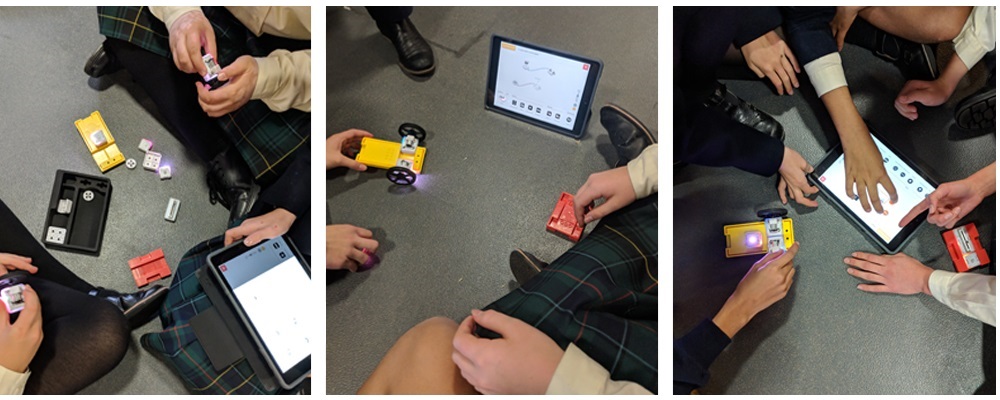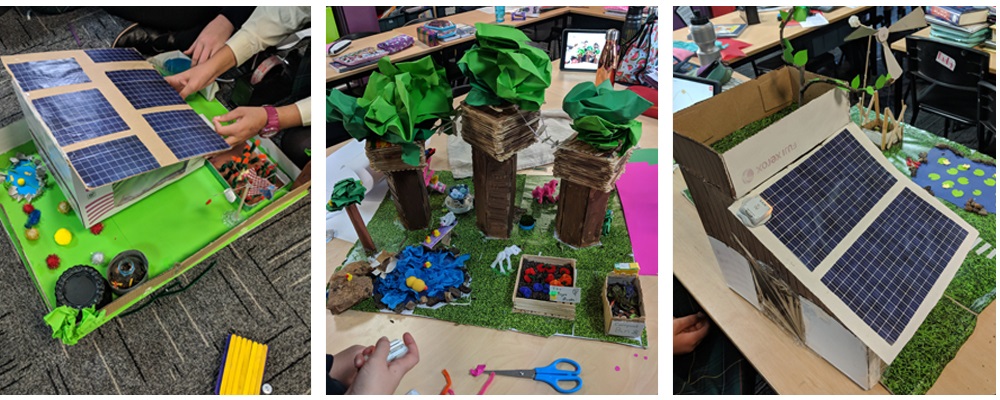I was fortunate to meet the SAM Labs team at the BETT Show earlier this year. Seeing the power of this technology immediately had me thinking of the possibilities this amazing resource could have in my classroom to drive student creativity and innovation.
There are a variety of SAM Labs kit options that each come packed with a range of wireless blocks and accessories including motors, sliders, buttons, lights, and sensors. Each block connects via bluetooth and acts as either an input or output. The power of these blocks is when used with the SAM Labs app or website. Students are able to program the blocks, using block code, to perform specific actions, allowing them to design any system their imagination allows.
I purchased the Curious Cars Kit and was extremely excited to share this with my colleagues and students. They were instantly hooked by SAM Labs, so my school invested in the Classroom Kit and STEAM Kit to ensure we had enough components for whole class learning activities.

To support teachers in implementing SAM Labs in their classrooms, they have created a range of lesson ideas and teacher support materials:
Link: https://int.samlabs.com/pages/teaching-materials that includes:
- Teacher guide
- Curriculum-aligned lesson plans covering a variety of subjects
- Inspiration and instructions for additional SAM Labs projects
- Downloadable and interactive activity logs
These user-friendly resources guide teachers and give them the confidence to successfully design their own learning experiences for their students.
I introduced SAM Labs to my students with structured time to explore and play with each of the blocks. This allowed each student to familiarise themselves with a range of possibilities of what could be achieved with this resource.
Below are the introductory lessons aimed at Year 6 students.
Lesson 1
Focus: Develop understanding of inputs and outputs
Resource:
- SAM Curious Cars app
The SAM Curious Cars app introduces students to each of the different SAM Labs blocks through gamification. Students develop their understanding of inputs and outputs by completing each stage of the app to create a remote control car on their tablet. Each stage introduces another SAM Labs block, adding further functionality to the car, until it is complete.
Lesson 2
Focus: Develop understanding of coding language in SAM Space App
Resources:
- SAM Space app
- Button or light sensor
- 2 x DC motors
- Tilt sensor
- Slider
The SAM Space app allows students to explore and develop their understanding of the SAM Lab coding functions. Students were set the task to physically build the car they created within the SAM Curious Cars app in Lesson 1. With limited instructions, students had to design, test and problem solve to develop each coding function to connect the SAM Labs blocks, enabling their car to manoeuvre around the room.

Lesson 3
Focus: Further develop understanding of coding language in SAM Space app
Resources:
- SAM Space app
- Button or light sensor
- 2 x DC motors
- RGB light
Demonstrating the Car Controller feature within the SAM Space app, students explored the functionality of using the tablet as a remote to manoeuvre their car. The students’ task was to continue developing their car from Lesson 2, transforming it into an ambulance with a flashing light and siren. Working in groups, they each tinkered with a range of functions to successfully create their ambulances with a variety of code, yet all achieving the same outcome. Each group shared with the class the code they developed to successfully create their ambulance, showcasing various strategies that were used and highlighting that there were multiple ways to achieve the end result.
Unit of Work
Each year, our Year 6 students complete a Sustainability unit of work. Part of this unit requires students to create a house, showcasing sustainable features that will have a positive impact on the environment.
With a slight redesign of this unit this year, which included the integration of components of the digital technologies curriculum, SAM Labs was used by students to allow their sustainable features to come to life and act as they would in a real house.
Students worked in groups of four to research and design their house with sustainable features. Each group was limited to five SAM Labs blocks and had access to a range of cardboard, paper and recycled materials to create their designs.
The incorporation of SAM Labs into this unit allowed students to produce their houses with a host of wonderful sustainable features. These included:
- Opening and closing curtains that are activated by light sensor
- Rotating clothes line to dry clothing faster
- Wind turbine to power an electric car: Watch Video
- House fan activated by light exposure: Watch Video
- Hydro-powered turbine to create electricity for the house: Watch Video
- Wind turbines to create electricity for the house: Watch Video

Designing learning experiences that incorporate SAM Labs has allowed our students to develop their creativity and innovative thinking to be able to solve problems relating to the real world. Teachers and students across our primary and secondary campuses have adopted this cordless digital technology with confidence due to its simplicity and functionality. With a little imagination, teachers can design exciting projects with SAM Labs, inspiring students to design, create, and problem solve to achieve success.
Featured Products: SAM Labs: Curious Cars Kit, Classroom Kit, STEAM Kit
How do you use SAM Labs in your classroom? We would love to hear from you!
About the author
Eleni Kyritsis is an award winning Year 3 teacher and Leader of Curriculum and innovation from Melbourne, Australia. Eleni facilitates professional learning workshops around the world that focus on unleashing creativity and curiosity in classrooms. You can contact her at elenikyritis.com and @misskyritsis
